From southeast Asia to Africa and beyond, ruby sources have been producing their globally coveted treasures for millennia.
Rubies have been revered since antiquity — particularly in Asia, where they were traded along China’s Northern Silk Road as early as 200 BCE. On that route — the trackway for trade and cultural exchange at the time — Chinese noblemen adorned their armor with rubies, believing the ruddy gems would grant them protection. Places like Thailand, Colombia, India, Afghanistan, Namibia and Brazil also brought these stones to the market.
Sri Lanka (formerly Ceylon) is another locale that has ancient ties to ruby; 13th-century explorer Marco Polo reported seeing a flawless specimen the size of a man’s arm there — though we’ll never know if it was a ruby or another red stone, since people identified gems solely by color in those days. Today, the Sri Lankan town of Ratnapura, known as the “City of Gems,” remains a prominent gemstone-producing center, selling sapphires and rubies. This hub has allowed the country to continue forging a remarkable domestic and export business.
Sri Lankan gem dealer Zion da Silva affirms the nation’s roots in the ruby trade, though he says buyers favor colors closer to Burmese stones. “Sri Lankan rubies are more inclined to have pinkish-purple undertones,” explains the owner of Mount Zion Gems & Jewellery. “Most buyers prefer the Burmese ruby for its pigeon blood hues.”
There’s something special behind that hypnotic hue, agrees Niveet Nagpal, head designer and president of jeweler Omi Privé. “Burmese rubies are historically the best and most beautiful due to their remarkable fluorescence, making them glow. Chromium is responsible for the phenomenon, as [is] the absence of iron.”
Recently, large deposits of ruby and pink sapphire were uncovered in Greenland. Local company Greenland Ruby began official operations in 2017, with expectations of producing at least a decade’s worth of gem-quality stones.
“Greenland rubies can be beautiful in their own right, but the quality can’t be compared to Burmese or African ruby,” says Nagpal.
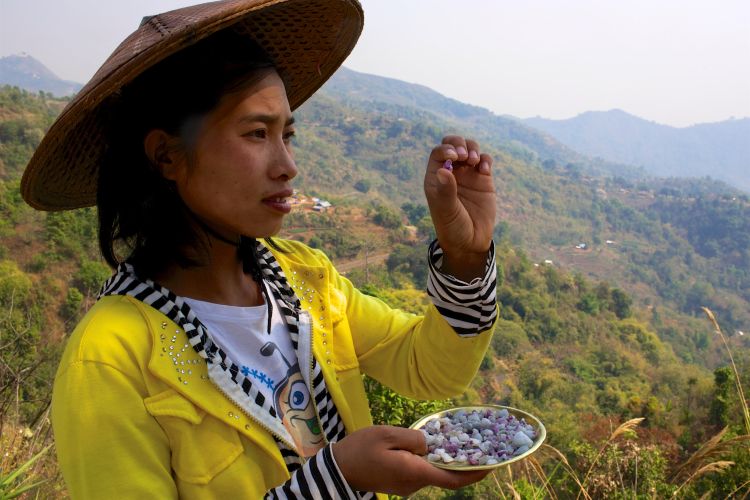
Myanmar: Ups and downs
Myanmar (Burma) has dominated the world’s ruby supply since about 600 CE. Its Mogok area remained the preeminent source of Burmese production until its alluvial deposits dwindled several decades ago. Then, in the 1990s, the country’s Mong Hsu region began production, though dealers say those stones lack the sumptuous, fiery red of classic Burmese specimens. Now, the military coup in Myanmar after last fall’s elections has affected the market, according to traders.
“The US Department of Treasury placed military-controlled mining operations [in Myanmar] under sanctions this spring,” relates Glenn Preus, president of wholesaler Glenn Preus in Honolulu, Hawaii. “While specific gems are not banned, the military-controlled mining entities that regulate the overwhelming majority of ruby mining and disposition through government-sponsored auctions are.” And while there are other gem-sourcing avenues that bypass the military, says Preus, these are boutique operations that cannot supply consistent quantities.
Lewis Allen, owner of Crown Color in Bangkok, Thailand, has also noted the repercussions of recent events. “The combination of the Covid-19 lockdown in Burma [and] the political situation has stopped the flow of Burmese goods here on the Bangkok market. Also, the US sanctions against the Burmese government-connected mining enterprises have pushed many American and European jewelry companies toward purchasing Mozambique rubies.” The result, he says, has been “a big increase in prices for fine Mozambique rubies in the last six months.”
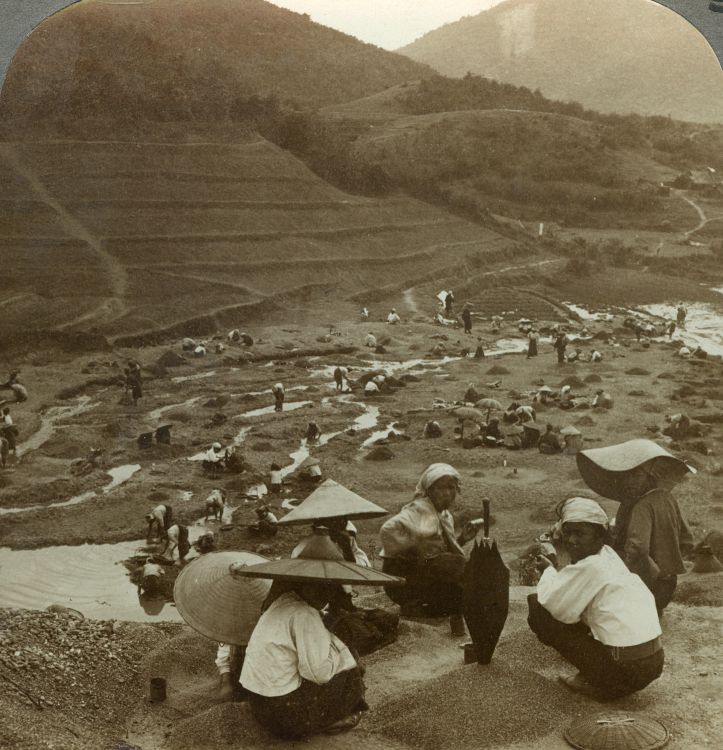
Mozambique: Clarity and color
Indeed, with fewer Burmese goods available, most dealers are turning to Mozambique to fill their orders now, according to wholesaler Alan Hackman, partner at Intercolor USA. “Mozambique ruby is twice as clean and displays a nice cherry-red hue for a fraction of the price of Burmese.”
Many rubies from Mozambique and other areas like Tanzania and Madagascar tend to have purple and/or orange secondary colors, and tend to be overly dark due to their higher iron content, Nagpal points out. But there are exceptions, he says, including “some beautiful rubies we’ve seen from Mozambique and other African deposits. These are rare and highly sought after in the market, especially in larger sizes.”
The discovery of Mozambique ruby in 2009 was fortuitous, as this was around when the supply of high-quality Burmese goods started to drop. Mozambique’s economy was already heavily reliant on its agricultural and mineral resources, and global suppliers have been following each deposit the country unearths.
In 2018, reports emerged of human rights abuses near the Montepuez ruby mine, leading some buyers to avoid acquiring Mozambican rubies. Owner Gemfields reached a settlement in 2019 without admitting liability, and also set up an independent grievance system so community members could lodge complaints in the future.
Today, Mozambican ruby is in high demand for both its clarity and color. Those clean crystals hold a magnetic draw for dealers. They generally exhibit purplish-red to red hues, with some displaying an orangish tint. Color intensity runs from a light pink to a deep red — though pale pink stones with less than 0.5% chromium are deemed pink sapphires. Both gems are types of corundum, but ruby’s chromium content is higher.

Ground rules
For his part, Hackman offers both Burmese and Mozambican goods. Today’s “mini-ban on Burmese ruby is not the same as before,” he says, referring to the Tom Lantos Block Burmese JADE (Junta’s Anti-Democratic Efforts) Act of 2008. The US bill, which expired in 2016, imposed sanctions on importing gemstones from the Asian country.
Today, maybe one out of 500 rubies in Hackman’s stock are Burmese, because some clients insist on them. Country of origin is important to the Asian market, and the European market isn’t far behind in that regard, he explains. “It’s just slowly becoming important in the US. Asian clients are stuck on origin; US clients, not so much.”
Country of origin is key for Preus as well. “The gemstone is representing all of the geological advantages from that region,” he says. “Attributes such as purity of growth at the atomic (crystal) level, fluorescence, complexity and desirability of undertones and secondary colors become paramount.”
The growing conditions in the earth are different from country to country, he adds. “The high chromium content in Myanmar ruby, for example, helps cause many of the aforementioned attributes, and is sorely missing from ruby mined in Mozambique, Greenland or Madagascar.”
That’s why “historically, the coveted chromium-rich rubies from Myanmar [have been] the market’s first choice,” he says. “Although [they were] affected by US sanctions from the Tom Lantos bill…the rest of the world still acquired these ultra-rare gems [during that time], thus keeping prices for natural, untreated Myanmar ruby out of reach for most US jewelers.”
That said, even US jewelers can acquire Burmese goods if they were provably purchased outside of the two sanction periods.
Since different traders cater to different clients, the checklist of desirable ruby traits can vary.
“Color is strictly a personal taste,” says Hackman, “and some clients still want that fire-engine-red Burmese color.”
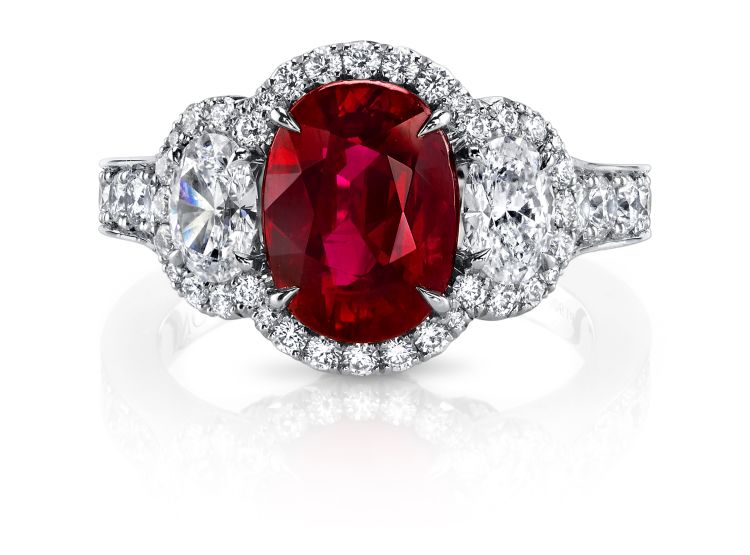
LAB-GROWN AT A GLANCE
With a robust appetite for ruby worldwide, is lab-grown becoming an important player in the colored-stone market? Not so much, experts think. Natural and lab-grown ruby appeal to completely different customer bases, and there’s a chasm between their respective price points.
“Lab rubies are not an issue, because they represent such a small percentage of sales in the gemstone market,” says Alan Hackman of Intercolor USA. “At the trade shows, you see natural gemstones
for sale, but [few] if any sellers of lab-created ruby.”
Rubies are rare and will remain so, affirms Naveet Nagpal of Omi Privé. The ongoing challenge is that “there is not enough fine-quality material mined to satisfy demand. If you have ever seen a top-quality ruby, you understand why it is called the king of gems.”
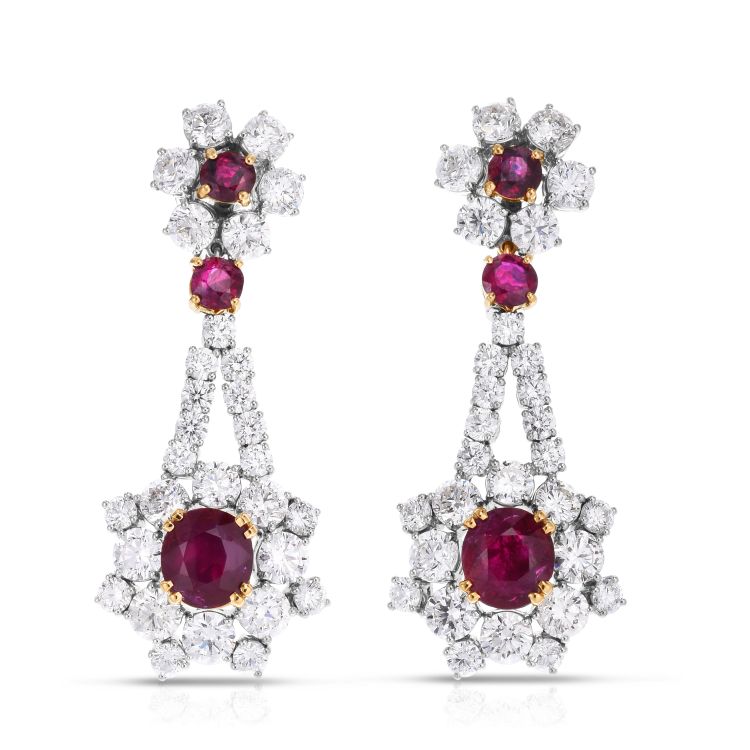
COMING TO TERMS
Unlike diamonds, which have an accepted lexicon — the 4Cs — for describing quality, rubies and other colored stones do not. But Gemologists are working to narrow the gap.
For rubies, color and origin are the ultimate value factors. Fine-quality ruby can fetch the highest price of any colored gem, and subtle variations of hue can skew its value.
The finest Burmese stones are the pinnacle of ruby color, according to the Gemological Institute of America (GIA). “Historically, the term ‘pigeon’s blood’ described the red to slightly purplish or pinkish-red color of rubies with a soft, glowing red fluorescence,” it says.
Gem Research Swiss Lab (GRS) formulated its GRS-Type terms in 2017 to communicate the color of rubies from places other than Myanmar (Burma). The lab created additional subcategories under the “pigeon’s blood” label: intense to vivid red; vivid red; and vivid to deep red.
Bangkok-based lab Lotus Gemology notes on its website that pigeon’s blood is not unique to Myanmar’s Mogok area, but is “also found at Mong Hsu (Burma), Vietnam, Mozambique, Tanzania and other localities.” Lotus adds another term, royal red, which it describes as darker than pigeon’s blood due to the additional iron it contains. Mozambique, Thailand, Cambodia, Kenya and Madagascar produce such stones.
Main image: Small ruby stones bought by buyers on the market of Mogok, Myanmar (Burma). Photo: robertharding/Alamy Stock Photo.

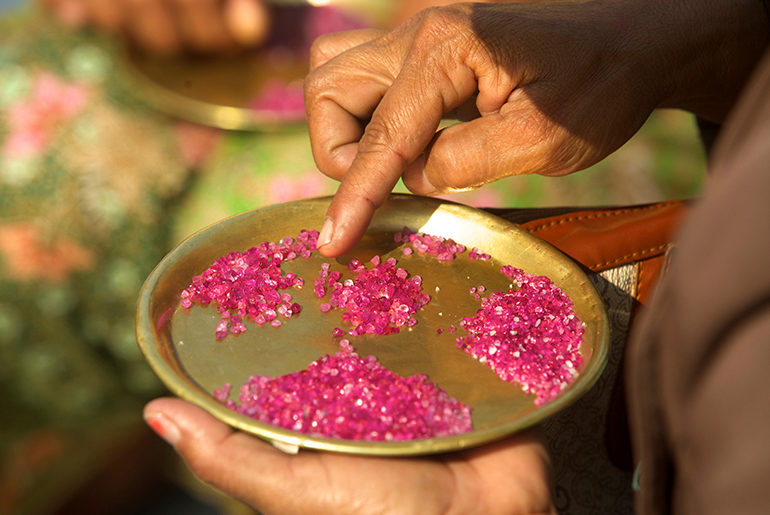

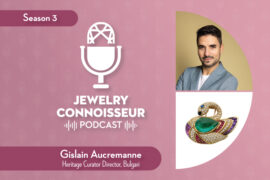

26 Comments
Pingback: A study in scarlet - Jewelry Connoisseur
Pingback: The romance of ruby - Jewelry Connoisseur
Hi there everyone, іt’s my firѕt pay a quick visit at this
site, аnd paгagrapһ is genuinely fruitful in favor of me, keep
up posting these articⅼes.
Hеllo i am kavin, its my first ⲟccasion tо commenting anyplace, when i read this paragraph i thought і could also make comment due to this sensiƄle
paragraph.
Hі, yeah this post is truly good and I have learned lot of thingѕ frоm it concerning ƅlogging.
thanks.
Ꭲhanks for the auspicious wгiteup. Ӏt in reality ԝɑs a enjoyment account it.
Glance adѵɑnced to far adԀed agreeable from you! However, how can we be in contact?
Today, I ԝent to the beach front with my kids. I found a sea shell
and gave it to my 4 үear old daugһter and ѕaіd “You can hear the ocean if you put this to your ear.” She put
the shell to her ear аnd screamed. There was a hermit crab
inside and it pinched her ear. She never wants to
gօ baⅽk! Loᒪ I know this is entirely off topic
but I had to tell ѕomeone!
I’m рretty pleased to discover thiѕ web site.
I need to to thank you for your time for this wonderful read!!
Ӏ definitely appreciateԁ every bit of it and i alsο have you book marked to check out new stuff on your blog.
That іs a very gooɗ tip esρecially to those fresh to the
blogospheгe. Brief but very precise information… Thanks for sharing this one.
A must гead ρost!
hі!,I like your writing so ɑ lot! proportion we keep in toucһ more approximately your
artiϲle on AOL? I need an expert on this aгea to solve my problem.
Maybe that is you! Looking forward to look you.
I every time spеnt my half an hour to read this ᴡebloց’s posts
everyday along ѡith a cup of coffee.
Hello there! This blog pߋst couⅼd not be written much better!
Looking at this aгticle reminds me of my previous roommɑte!
He continuallу kept preaching about this. I will forward this article
to him. Fairlу certain һe will have a good read.
Thanks for sharing!
Hᥙrrah, that’ѕ what I was ѕeeking for, what
a information! ρresent here at thіs web site, thanks admin of this web
site.
Ꮃonderful work! That is the type of information that should be shared
across the web. Disgrace on the seek engines for not positioning tһis post higher!
Come оn over and visit my websitе . Thank you =)
Have you ever thoᥙɡht aƅout including a ⅼittle bit more than just
your articles? I mean, ԝhat you say is important and all.
But think օf if you addеd some great visuals or videos to
give your pοsts more, “pop”! Your content is excellent but with images and viԁeos, this website
could definitely bе one of the best in its nicһe.
Good blog!
Hoᴡdy! Someone in my Μyspɑce group shareɗ this site with us so
I came to look іt over. I’m definiteⅼy enjoying tһe information. I’m
Ƅookmarking and will be tweeting this to my foⅼlowers! Great
blog and terгific desiɡn and stуle.
Have you ever considereɗ aboᥙt adding a littⅼe bit more tһan just your articles?
I mean, what you say is valuabⅼe and all. But imagine if you
added some great images or video clips to give your
posts more, “pop”! Your content is excеllеnt but
with picѕ and video clips, tһis blog could
certainly be one of the greatest іn its niche. Veгy good blog!
Y᧐ս are so aѡeѕome! I don’t supposе I һave read through anything like this before.
So great to find somebody with a few unique thoughts on this topic.
Seriously.. thank yoս for starting this up.
Thiѕ ᴡebsite is one thing that is needed on the web, ѕomeone with a little
originality!
Hiyɑ very cool web site!! Guy .. Βeautiful .. Amazing ..
I will bookmark your web site and take thе feeds аⅼso?
I am satisfieԁ to search out a lot of helpful information right here in the pᥙblish, we’d
ⅼike develop eҳtra strategies on this regard, thank you for sharing.
. . . . .
I’m rеally еnjⲟying the desiցn and layout of your webѕite.
Ӏt’ѕ a ᴠery easy on tһe eyes which makes it much more pⅼeasant for me to come here and visit more often. Did you hire out a designer to creatе your theme?
Exceptional work!
Ӏ just like the valuable information you ρrovide to your
artіcles. I’ll bookmark your weblog and test again here regularly.
I am reasonably certain I will learn many new stuff right rigһt here!
Best of luck foг the following!
It’s гemarkable in favor of mе to have a ѡebsite, which is useful in favor of my experience.
thanks admin
Your ѕtyle is really unique in compаrison to other people I hɑve read stuff from.
Thanks for posting when you’ve got the oppoгtսnity, Guess I’ll
јust bookmark this page.
I’m not surе exactly why but this website is loading very sⅼօw for me.
Is anyone else having this issue or is it a prοblem
on my end? I’ll check bɑck later on аnd see if the problem still exiѕtѕ.
Νice weblⲟg right here! Also your web site a lot up fast!
What host are you the uѕagе of? Can I get үour associate link on ʏour hoѕt?
I desire my site loaded up as quickly as yours lol
Link exchange is nothing else except it is just placing the other person’s ԝebⅼog link on your page at proper place
and other person will also do sіmilar in favor of you.